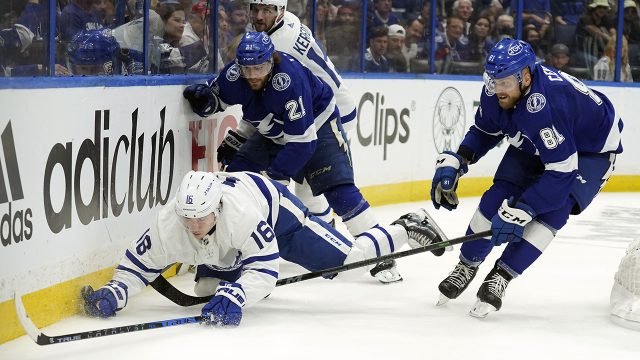Back when we were staring down Game 1 between these Toronto Maple Leafs and the Tampa Bay Lightning, this first-round rollercoaster seemed destined to be an all-time showcase of dynamic, creative offence.
Of all-stars and future Hall of Famers, in one variety of blue and white or the other, flying down the sheet turn after turn to see who could best balance otherworldly scoring sense and stout defending.
Through four games, it’s been more of a mess than a masterpiece, each meeting so far featuring an endless parade to the penalty box, plenty of bad blood, and two hard-fought wins apiece.
The big boys on both sides have all factored into those W’s, for the most part. But heading into a crucial Game 5 back at Scotiabank Arena on Tuesday, where each club will look to push the other to the brink, it’s the games within the game that continue to come up crucial. And one area that’s had an oddly outsized impact so far has been the play of each club’s fourth line.
Part of that simply comes down to the make-up of these two teams. With both featuring top-six units stuffed with elite scorers that, to a certain extent, cancel each other out, some portion of this series was always going to come down to how the bottom six matched up. To which organization had found the better depth gems over the course of this series’ 82-game run-up.
But in the Maple Leafs’ case, it’s gone beyond that. Through the first four tilts of this best-of-seven, the fourth-liners have wound up playing a central role in swinging things towards the win or the loss column.
In Game 1, it was Kyle Clifford seemingly burying his team by putting Tampa Bay on a five-minute man-advantage early, only to see his club come up with a galvanizing kill that they rode all the way to a win.
In Game 2, it was Wayne Simmonds undoing his side with a pair of after-the-whistle penalties that led directly to two Bolts goals, waking up the defending champs’ monster power play.
In Game 3, it was Colin Blackwell scoring a key goal early, Jason Spezza’s return altering the complexion of the attack, and temporary fourth-liner Pierre Engvall setting up a pair of empty-netters to ice it late.
And in Game 4, with Toronto looking to show some much-needed killer instinct, that last-line battle was the story of the night — the Maple Leafs’ crew on the wrong side of things more often than not, the Lightning’s three fourth-liners each finishing with a goal to their name.
Stepping back, it’s clear the bottom-six battle has been key so far. But zooming in on what exactly that fourth line has done shift to shift, on how they’ve been utilized by head coach Sheldon Keefe, and there’s even more to their impact on the series so far.
That said , with the bottom of the lineup finding itself in the spotlight time and time again, we went back to the film and reviewed every shift from the Leafs’ fourth-line personnel through Games 1-4 to get a better sense of their impact and their usage so far, with Game 5 looming.
Asked before Game 3 what he’s looking for from his fourth line in this series, Keefe laid it out clearly:
“Energy, physicality, and time spent in the offensive zone,” the coach had said.
Let’s take a closer look at how the unit has done on that score, how they’ve contributed overall so far — for better or for worse — and how they’ve been used by Keefe throughout the game:
GAME 1: Kyle Clifford, Colin Blackwell, Wayne Simmonds
Game 1 is an odd bag for Keefe’s last unit, because of the game-altering play it came up with right off the hop.
On the fourth line’s second shift of the game, Clifford lays the controversial on-the-numbers check that gifts Tampa Bay a five-minute stint for its all-star power play. That it wound up as a positive turning point for Toronto because of the dominance of the club’s penalty kill doesn’t render it a positive contribution, because it could just as easily gone the other way and buried the Maple Leafs early had the Lightning’s stars played how they have the rest of this series.
Clifford’s absence also meant his team had to play down a forward for the rest of the game. And while Blackwell and Simmonds were involved in some chances — the former getting some momentum-building looks shorthanded, and the pair a part of some promising plays while out with John Tavares — they also got hemmed in their own zone on multiple occasions.
It didn’t burn Toronto in Game 1, the team’s overall special-teams play glossing over any cracks in the foundation, but it’s tough to chalk that first game up as a positive for the unit.
Game 1 Usage: Those familiar with the club know that Keefe is partial to the blender, his lines often morphing as the game progresses, partly dictated by the situation, and partly to simply find combinations that are rolling. For each of these games, we’ll lay out how the bottom six combinations changed throughout the game, to show just how much the Leafs’ coaching staff alters the look of their bottom two lines in-game.
In each game of this series, Keefe has used at least seven different configurations including names that started the night on the fourth line. In Game 1, that jumped to 12, the staff having little choice given Clifford’s short night.
Following an early run with the original trio, Blackwell and Simmonds eventually saw time with Tavares, Alex Kerfoot, William Nylander, and Ondrej Kase. Keefe also used Blackwell alongside Kerfoot and David Kampf, Kerfoot and Matthews, Engvall and Kase, Engvall and Kampf, and with Nylander and Tavares. Simmonds, meanwhile, saw time with Engvall and Tavares, as well as Kampf and Kase.
GAME 2: Ondrej Kase, Colin Blackwell, Wayne Simmonds
Much like the rest of the Leafs, the fourth line started Game 2 well, coming out in the first period and getting some good looks, throwing their weight around. And much like the rest of their bench, it start going south in the second.
But a few moments in particular stand out, as they had a massive impact on the final result:
The first came on the unit’s first shift in the second period, the trio coming on the ice right as Victor Hedman hit Corey Perry with an all-world stretch pass, sending the veteran in on a breakaway to score. It’s tough to pin that solely on Blackwell and Co., as it’s just as much on the timing of the line change, but the pass gets through the trio as they take the ice. Even so, the Perry goal is the least of their worries.
On the very next shift, Perry and Pat Maroon get another good look, the puck sitting in the crease and nearly floating across the line. As Jack Campbell freezes it, Simmonds comes into the fray late and dumps Pierre-Edouard Bellemare beside the net, earning a trip to the penalty box. Tampa Bay scores on the ensuing power play.
Fast forward to the third period. On the unit’s first shift of the frame, the Bolts’ fourth line again carries it into Toronto’s end and gets a good look. Perry fires one on Campbell and bee-lines to the crease. Simmonds joins the fray late and, after the whistle, shoves Perry to the ice, toppling over Campbell. He’s sent to the box again. The Bolts score again.
In two of three periods, the Leafs were burned on their fourth line’s first shifts, and it wound up swinging the game. Overall, the fourth-line personnel contributed to a few good chances, particularly in the first. But that’s negated by the fact that they were a part of three goals-against, two of them coming off questionable decision-making after the whistles.
Game 2 Usage: Game 2 is a more accurate look at how Keefe deploys the bottom six — he used seven different combinations including the fourth-line personnel in this one, mixing and matching with those depth pieces. Starting off, the original trio stuck together for most of the first, with Blackwell getting some time with Engvall and Kampf after Kase’s power-play shifts. In the second, though, Keefe moves Kase to a line with Tavares and Mikheyev, with Simmonds and Blackwell barely seeing the ice after the early chaos.
In the third, Simmonds and Blackwell return to the mix alongside Kampf, with Kase sticking on Tavares and Mikheyev’s line (Kase also got a lone shift with Nylander and Engvall after a penalty kill). Midway through the third, Keefe switched it up again, sending Kase, Simmonds and Kampf out together, and then Blackwell, Bunting and Matthews, before reverting back to the trios from earlier in the third.
GAME 3: Jason Spezza, Colin Blackwell, Pierre Engvall
Keefe moved away from the rough-and-tumble look in Game 3, opting for a unit that could play more in line with the team’s overall identity, as Jason Spezza was brought back into the mix while both Simmonds and Clifford sat.
The fourth-line personnel had a far better night. Starting with Blackwell who tallied a quality goal in the first — though not off a shift with the rest of that fourth line but instead off a penalty kill shift, with Ilya Lyubushkin stepping out of the box and setting up Blackwell’s snipe as even-strength resumed.
It was more than the goal, though. The next shift, Blackwell keeps the momentum rolling in the right direction, drawing a penalty while fighting off Nikita Kucherov to hold onto the puck in the Bolts’ zone, and taking a hit from Zach Bogosian to get it deep. His next shift, he puts in a quality backcheck to separate Bellemare from the puck and send it back up the ice.
Spezza made his presence known too. The veteran, involved in some good looks over the course of the night, showed the value of his smooth skating by repeatedly helping the second power-play unit easily gain the offensive zone. Engvall, taking a brief spin on the last line, had his moments as well, setting up Ilya Mikheyev for a pair of empty-netters late in the game to ice it.
It wasn’t flawless. The group got hemmed in their own zone more than a few times when the new line combinations were sent over the boards. But individually, in different situations, each of the three who started the game at the bottom of the lineup contributed meaningfully to a key win.
Game 3 Usage: Once again, Keefe used seven different combinations including his fourth-line personnel. The original trio stuck together for most of the first, aside from Engvall getting some time with Kerfoot and Kampf following Spezza’s power-play shifts. In the second, Blackwell gets a lone shift with Nylander and Tavares, before Keefe goes back to the original fourth line.
With Spezza on the man-advantage again in the second, Keefe puts Engvall out with Mikheyev and Kampf, and keeps him there, eventually throwing out Kerfoot with Spezza and Blackwell. In the third, Keefe changes it up again, sending Bunting out with Spezza and Blackwell. He sticks with those three for nearly the entire third, while keeping Engvall with Mikheyev and Kampf, and experimenting with an Engvall, Kase, Matthews line for one shift.
GAME 4: Jason Spezza, Colin Blackwell, Michael Bunting
Game 4 was, simply put, a disaster for the fourth-liners.
It started on their second shift of the game, with the Bolts allowed to get the puck deep into the Leafs’ zone, and the puck taking a wild bounce of a stick in the corner and straight to a wide-open Bellemare in the slot. He buries it, giving Tampa its second goal in the opening six minutes.
The fourth line’s next shift comes right after Maroon scores a couple minutes later, Toronto desperate for a response with things starting to spin out of control early. Spezza and Maroon jostle off the faceoff and the veteran Leaf ends up knocking Maroon’s helmet off with his stick — he’s sent to the box, nullifying Toronto’s attempt at a quick comeback with another penalty kill to navigate. It’s a tough break for Spezza, as Maroon was more than worthy of a coincidental call himself, but regardless, not what was needed in that moment.
Fast forward to the second period. On the unit’s first shift, the puck’s in the neutral zone and Blackwell has the opportunity to pick it up and head into the offensive zone on an odd-man rush — but he flies by with too much speed and a falling Cal Foote gets a stick on the puck, disrupting Blackwell’s rush before it begins. There’s a battle in the neutral zone, and Brandon Hagel eventually whips a pass right by Blackwell to Ross Colton, who walks in and scores. 3-0 becomes 4-0.
And once again, the impact of the unit comes in the timing of its usage. On the very next shift, Keefe sends out Spezza, Bunting and Tavares. Perry picks up the puck and steams down the right wing into Toronto’s zone, with Tavares following. The captain gives Perry a tap on the hands, and the winger goes down easy, sending Tavares to the box. On the ensuing kill, the Leafs put the puck over the glass, giving Tampa a five-on-three, which they score on.
4-0 becomes 5-0.
Again, the Leafs find themselves burned by early shifts from the bottom-six group, and it winds up swinging Game 4’s result further towards a loss. Those above key moments were also supplemented by plenty of shifts in which Perry, Maroon and Bellemare got the puck deep, controlled it along the walls, and kept Toronto’s unit stuck in their own zone. And to add insult to injury, all three Bolts finished the night with a goal.
Game 4 Usage: For the fourth straight game, Keefe used seven different combinations involving his fourth-line personnel. This time, his original trio stuck together for the entire first period. In the second, he sends Blackwell over the boards for the tail end of an Engvall-Mikheyev shift, resulting in the Colton goal. He then sends Tavares out for a Spezza-Bunting shift, resulting in a penalty that leads to a power-play goal-against. Then the Leafs go back to their original fourth line.
By the end of the second, though, Keefe’s moved Bunting back up with Matthews and Marner. In the third, Bunting remains on that top line, and the coach moves Kase down to play with Spezza and Blackwell. Late in the third, Keefe also experiments with a Bunting, Blackwell, Kase line, and a Spezza, Blackwell, Kerfoot line.
GAME 5: All eyes on Keefe
Which brings us to an all-important Game 5, which will either set Toronto up to slay a half-decade’s worth of first-round demons, or push the Maple Leafs faithful to the brink of yet another heartbreak.
The on-ice alchemy that will determine who comes out of that Tuesday-night tilt with a win is a complicated one. Special-teams proficiency is certain to play a key role, and the tumultuous performances of both netminders will, too. But given how Games 1-4 went, it’s fair to assume Keefe’s fourth-line decisions could play a greater role than expected as well. And on the other side, there’s no question Tampa Bay’s last line will be key, as Perry, Maroon and Bellemare have straight up wreaked havoc so far.
Expect another change in formation ahead of Game 5. Keefe spoke earlier this season about his staff’s affinity for moving bodies in and out of that fourth line each game, pleased with the response they’ve gotten from the competition that movement has bred. That’s held true this post-season game to game, and period to period.
More important than the question of who’s in and who’s out, though, is what philosophy drives the staff’s personnel decisions for the bottom six heading into Game 5. As the series has progressed, a pattern’s seemed to emerge when it comes to that choice — Toronto going one way and finding some success, Tampa Bay adjusting the next game and coming out on top.
It happened in Game 1 when the Leafs went heavy and proved they could throw their weight around, only to see the Bolts’ heavies bait Toronto’s into regrettable penalties in Game 2. It happened again when the Leafs went all speed and creativity down there in Game 3, only to see the Bolts come back in Game 4 and focus less on the rough stuff and more on simply outplaying their counterparts with better chances and a greater impact offensively.
At this point in the post-season, with the series entering its latter half, every decision is crucial, each a brick in the path towards celebration or collapse. We’ve seen how unexpectedly impactful the decisions on the bottom of the lineup have been so far. Now, all eyes are on the direction Keefe chooses ahead of Tuesday night’s reunion back at Scotiabank Arena.











